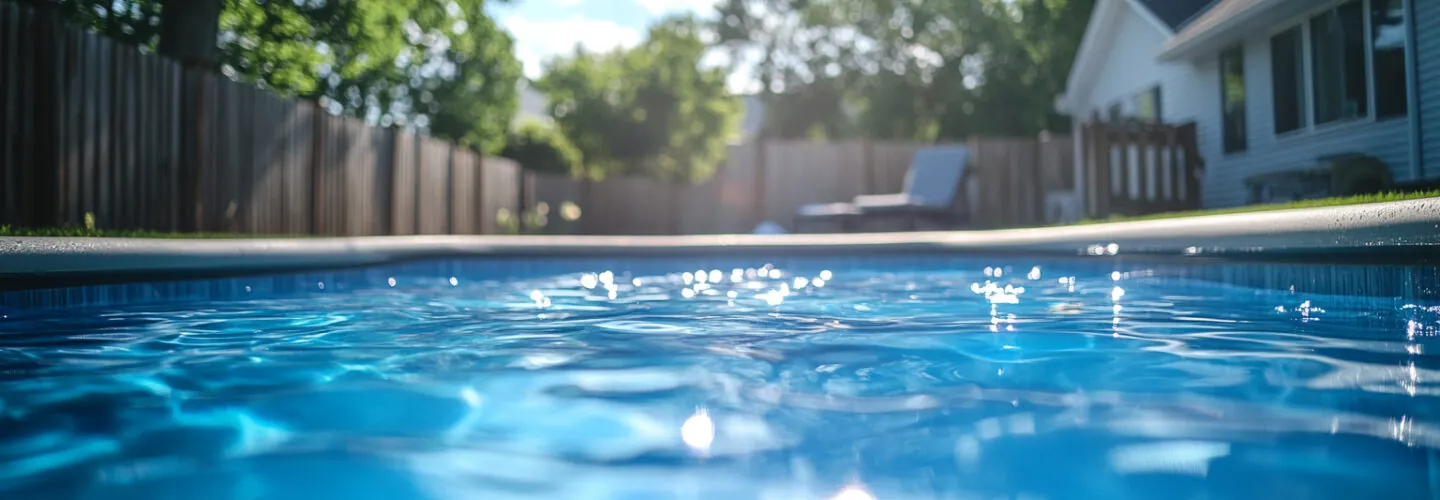
Poolie Team: Aug 29, 2024
Ever dreamed of a backyard oasis without the hassle of constant pool upkeep?
Fiberglass pools seemed like the perfect solution, right? They are, but even the sturdiest fiberglass can develop cracks, turning your dream pool into a leaky nightmare. These cracks are more than just unsightly–they can lead to costly repairs and massive water waste.
So, what’s the big deal about fixing them? Well, it’s not as simple as patching a hole in a tire. Finding the exact culprit can be a detective’s job, especially when cracks hide beneath the water’s surface.
In this article, we’ll discuss the common causes of fiberglass pool cracks, the challenges pool owners face in repairing them, and the importance of finding and addressing the underlying leak source.
Identifying Cracks and Damage in Fiberglass Pools
Early leak detection can save money and prevent major problems. This is why you should try to identify the cause and pinpoint the exact location at the first sign of a leak.
Common Types of Fiberglass Pool Damage
Knowing common fiberglass pool damage–like spider cracks, bulging walls, and fading–can help pool owners fix problems promptly.
Let’s examine these types of pool cracks and how to spot them.
Spider Cracks
Spider cracks are thin, web-like cracks that appear on the surface of a fiberglass pool. These cracks are typically shallow and affect only the gel coat layer.
You can identify spider cracks by their distinctive pattern. As their name suggests, they resemble a spider web.
The main causes of spider cracks include excessive pressure, improper installation, or blunt force impacts.
While they might seem minor, spider cracks can compromise the pool’s structural integrity over time. If left unaddressed, this leads to more significant problems.
Pool Walls Bulging
Bulging pool walls appear as outward deformities along the pool walls. This problem is often due to hydrostatic pressure when groundwater pressure pushes against the pool structure or poor installation practices.
Bulging walls need professional help, as this issue can worsen and potentially lead to structural failure. Proper installation and managing groundwater can prevent this issue.
Fading and Discoloration
Fading and discoloration in fiberglass pools refer to the loss of color and the appearance of uneven spots on the pool’s surface.
Early signs include dulling of the pool’s bright finish and patches of discoloration.
The primary factors contributing to fading and discoloration are UV exposure and chemical imbalances in the pool water.
To mitigate these issues, maintain proper chemical levels and use pool covers to protect the pool’s surface from harmful UV rays. Regular cleaning is also essential to preserve the pool’s appearance.
Your DIY Guide to Fixing Fiberglass Pool Cracks
Fixing fiberglass pool cracks yourself can be a rewarding project. Here’s how to do it properly:
Step 1 – Start by Draining and Inspecting Your Pool
Before starting any repairs, you must safely drain your fiberglass pool. Use a submersible pump, ensuring it’s rated for your pool size and connected to a GFCI outlet to prevent electrical hazards.
Once your pool is drained, conduct a thorough inspection. Check the pool’s surface meticulously, especially along the waterline, steps, and corners. Look for signs of cracks, bulges, or discoloration. Note any areas needing attention.
Step 2 – Sand the Damaged Area Smooth
Remove any debris, dirt, or loose materials to prepare the damaged area. Then, lightly sand the surface with 80-grit sandpaper, using moderate pressure.
This step ensures a smooth, even surface for the bond coat application, which is essential for proper adhesion of the repair materials.
Step 3 – Apply a Strong Bond Coat
A strong bond coat ensures the polyester putty and gel coat adhere to the fiberglass. Mix the bond coat according to the manufacturer’s instructions to ensure a consistent blend.
Using a brush or roller, apply the bond coat evenly over the sanded area. Allow it to dry and cure completely, which can take several hours.
Be patient. Skipping this step could lead to premature failure of the repair.
Step 4 – Use Polyester Putty for Filling
Once the bond coat is cured, apply polyester putty to the crack. Mix the putty according to the instructions, ensuring a smooth and even application.
Use a putty knife or even a plastic spoon to blend the putty seamlessly with the pool’s existing surface.
Allow the putty to harden completely before proceeding.
Step 5 – Finish with Gel Coat and Fiberglass Cloth
Apply a gel coat matching your pool’s original color to protect and seal the repair. Use a brush or roller to apply it evenly in thin layers, avoiding bubbles.
Then, place a piece of fiberglass cloth over the wet gel coat and press gently. This extra pressure adds strength to the repair. Allow everything to cure entirely before refilling your pool.
Your fiberglass pool crack is now successfully repaired!
Getting Your Fiberglass Pool Professionally Repaired
While DIY fiberglass pool repairs can be rewarding, professional help is often essential for complex or extensive issues.
When to Opt for Professional Repair Services
Some pool issues are not DIY-friendly. Here are situations where calling in trained professionals is recommended:
Extensive Cracking
Professional repair services are necessary if your pool has multiple or widespread cracks.
Extensive cracking can indicate underlying structural problems that need to be addressed with specialized tools and skills.
Deep or Penetrating Cracks
Deep or penetrating cracks that go beyond the gel coat layer and into the fiberglass structure require expert attention. These types of cracks can compromise the pool’s integrity and are best managed by professionals who can ensure a thorough and secure repair.
Cracks in Structural Areas
Cracks located in critical structural areas, such as the pool’s walls or floor, pose a significant risk to the pool’s stability. These cracks need professional assessment and repair to prevent structural failure and ensure safety.
Recurrent Cracks
If you’ve repaired a crack before and it has reappeared, this is a sign of an underlying issue that a DIY approach might not fully resolve. Professionals can diagnose the root cause and provide a more permanent fix.
Cracks with Water Leaks
When water leaks accompany cracks, seek professional help immediately. Leaks can lead to water loss, increased chemical usage, and damage to the surrounding area.
Professionals have the equipment and expertise to detect and repair leaks effectively.
Chemical Damage-related Cracks
Cracks caused by chemical damage can be complex to repair. To prevent further damage, correct the pool’s chemical balance.
Professionals handle both chemical adjustments and crack repair.
What to Expect in Terms of Cost
The cost of professional fiberglass pool crack repairs can vary based on several factors:
- Extent of Damage: Minor repairs are generally less costly than extensive damage.
- Location of Cracks: Cracks in easily accessible areas are less expensive to repair than those in hard-to-reach spots.
- Labor Costs: Labor costs vary based on location and repair complexity.
- Materials Used: High-quality materials offer better durability but may be more expensive.
- Additional Services: Leak detection, chemical balancing, or structural assessments can increase costs.
Maintenance Tips for Long-Lasting Fiberglass Pools
Like other pool types, fiberglass pools require regular maintenance to prevent issues, save on costly repairs, and ensure your pool remains functional.
Stay on Top of Acidity and pH Levels
A balanced pH level ensures a swim-safe and healthy pool water. Imbalanced pH can cause corrosion, scaling, and swimmer discomfort.
- Test Regularly: Use a test kit or strips to check pH at least twice a week.
- Ideal Range: The ideal pH for fiberglass pools is 7.2 to 7.6.
- Adjust as Needed: Add pH reducers or increasers to adjust levels.
- Follow Instructions: Follow the manufacturer’s instructions for adding chemicals. Make incremental adjustments to avoid over-correction.
Keep That Filter System Running
Your pool’s filter is its heart and soul. Running it regularly ensures clean, healthy water.
- Run Time: Aim for 8-12 hours of daily operation, especially in peak swimming season.
- Regular Cleaning: Backwash or rinse filters regularly to maintain efficiency.
- Monitor Pressure: Watch the pressure gauge. Higher readings signal the need for cleaning.
- Professional Maintenance: Schedule yearly professional servicing.
Don’t Skip Regular Cleaning and Inspections
A clean pool isn’t just about looks—it’s also about hygiene and preventing damage.
Here’s a simple cleaning and inspection routine to follow:
- Daily Skimming: Remove leaves, bugs, and other debris with a skimmer.
- Weekly Vacuuming: Vacuum the pool floor to remove dirt and debris settling at the bottom.
- Weekly Brushing: Prevent algae buildup and maintain a smooth surface by brushing the walls and floor.
- Regular Inspections: Check for wear, cracks, or malfunctions. Early detection saves money.
Preserve the Lifespan of Your Pool
Want your fiberglass pool to stay sparkling and inviting for years to come?
A little TLC goes a long way. Keep the water clean, the filter running smoothly, and the chemicals balanced. With some care and attention, your fiberglass pool will be a source of joy and relaxation for many years.
It’s all about regular check-ups and a little DIY know-how. Look for signs of trouble, like cracks or discoloration, and tackle minor issues yourself.
But don’t hesitate to call in the experts when it comes to major repairs.
Let’s Enhance Your Pool Experience Together
And if you’re somewhere in Texas, Poolie is the team that would truly understand you and meet your pool’s needs.
We invite you to share your story with us. Please fill out the form below to chat with one of our friendly team members. Tell us about the challenges you are facing with your fiberglass pool and what you feel has been missing from other service providers.
We’re ready to provide the solutions you need. Let’s make your pool a source of joy and relaxation.
Join Our Tribe of Delighted Texas Pool Owners
Forget the hassle of pool maintenance.
Poolie’s team of professionals can keep your pool serene and inviting without you lifting a finger. We offer everything from detailed cleaning to emergency repairs and restoration.

![How to Select the Best Type of Pool Filter: Efficiency, Cost, and Maintenance Explained [Featured Image]](https://poolie.com/wp-content/uploads/2024/08/Featured-Image-050-250x170.jpg)
![Experience the Future of Pool Maintenance: A Guide to Automation Systems [Featured Image]](https://poolie.com/wp-content/uploads/2024/08/Featured-Image-049-250x170.jpg)
![Inground Pool Services Explained: Comprehensive Maintenance & Care Guide [Featured Image]](https://poolie.com/wp-content/uploads/2024/08/Featured-Image-048-250x170.jpg)